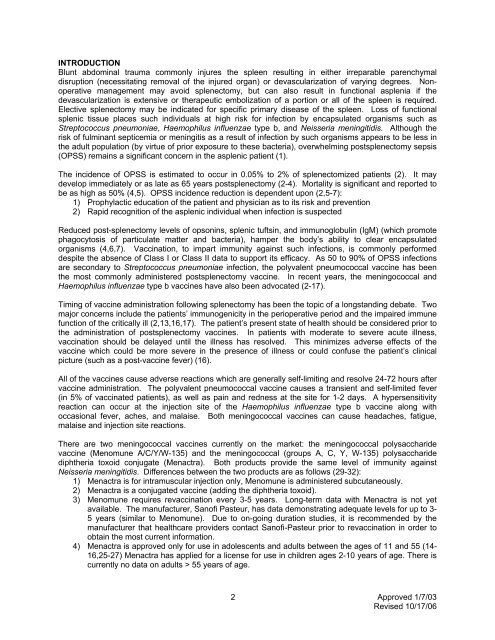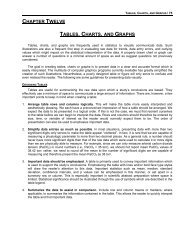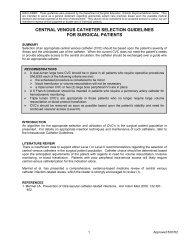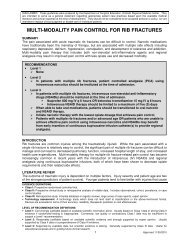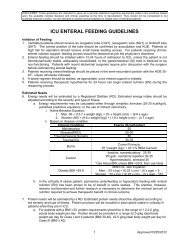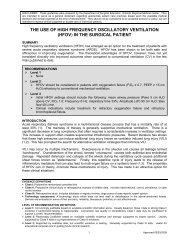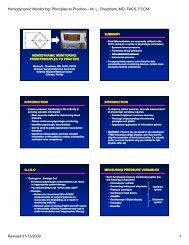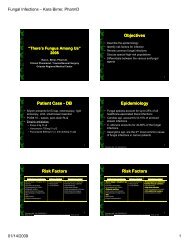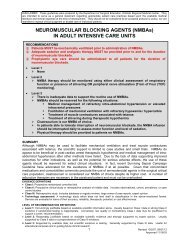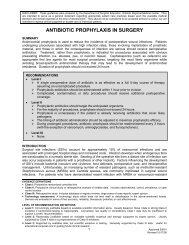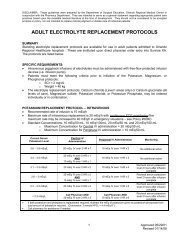post-splenectomy vaccine prophylaxis - SurgicalCriticalCare.net
post-splenectomy vaccine prophylaxis - SurgicalCriticalCare.net
post-splenectomy vaccine prophylaxis - SurgicalCriticalCare.net
You also want an ePaper? Increase the reach of your titles
YUMPU automatically turns print PDFs into web optimized ePapers that Google loves.
INTRODUCTION<br />
Blunt abdominal trauma commonly injures the spleen resulting in either irreparable parenchymal<br />
disruption (necessitating removal of the injured organ) or devascularization of varying degrees. Nonoperative<br />
management may avoid <strong>splenectomy</strong>, but can also result in functional asplenia if the<br />
devascularization is extensive or therapeutic embolization of a portion or all of the spleen is required.<br />
Elective <strong>splenectomy</strong> may be indicated for specific primary disease of the spleen. Loss of functional<br />
splenic tissue places such individuals at high risk for infection by encapsulated organisms such as<br />
Streptococcus pneumoniae, Haemophilus influenzae type b, and Neisseria meningitidis. Although the<br />
risk of fulminant septicemia or meningitis as a result of infection by such organisms appears to be less in<br />
the adult population (by virtue of prior exposure to these bacteria), overwhelming <strong>post</strong><strong>splenectomy</strong> sepsis<br />
(OPSS) remains a significant concern in the asplenic patient (1).<br />
The incidence of OPSS is estimated to occur in 0.05% to 2% of splenectomized patients (2). It may<br />
develop immediately or as late as 65 years <strong>post</strong><strong>splenectomy</strong> (2-4). Mortality is significant and reported to<br />
be as high as 50% (4,5). OPSS incidence reduction is dependent upon (2,5-7):<br />
1) Prophylactic education of the patient and physician as to its risk and prevention<br />
2) Rapid recognition of the asplenic individual when infection is suspected<br />
Reduced <strong>post</strong>-<strong>splenectomy</strong> levels of opsonins, splenic tuftsin, and immunoglobulin (IgM) (which promote<br />
phagocytosis of particulate matter and bacteria), hamper the body’s ability to clear encapsulated<br />
organisms (4,6,7). Vaccination, to impart immunity against such infections, is commonly performed<br />
despite the absence of Class I or Class II data to support its efficacy. As 50 to 90% of OPSS infections<br />
are secondary to Streptococcus pneumoniae infection, the polyvalent pneumococcal <strong>vaccine</strong> has been<br />
the most commonly administered <strong>post</strong><strong>splenectomy</strong> <strong>vaccine</strong>. In recent years, the meningococcal and<br />
Haemophilus influenzae type b <strong>vaccine</strong>s have also been advocated (2-17).<br />
Timing of <strong>vaccine</strong> administration following <strong>splenectomy</strong> has been the topic of a longstanding debate. Two<br />
major concerns include the patients’ immunogenicity in the perioperative period and the impaired immune<br />
function of the critically ill (2,13,16,17). The patient’s present state of health should be considered prior to<br />
the administration of <strong>post</strong><strong>splenectomy</strong> <strong>vaccine</strong>s. In patients with moderate to severe acute illness,<br />
vaccination should be delayed until the illness has resolved. This minimizes adverse effects of the<br />
<strong>vaccine</strong> which could be more severe in the presence of illness or could confuse the patient’s clinical<br />
picture (such as a <strong>post</strong>-<strong>vaccine</strong> fever) (16).<br />
All of the <strong>vaccine</strong>s cause adverse reactions which are generally self-limiting and resolve 24-72 hours after<br />
<strong>vaccine</strong> administration. The polyvalent pneumococcal <strong>vaccine</strong> causes a transient and self-limited fever<br />
(in 5% of vaccinated patients), as well as pain and redness at the site for 1-2 days. A hypersensitivity<br />
reaction can occur at the injection site of the Haemophilus influenzae type b <strong>vaccine</strong> along with<br />
occasional fever, aches, and malaise. Both meningococcal <strong>vaccine</strong>s can cause headaches, fatigue,<br />
malaise and injection site reactions.<br />
There are two meningococcal <strong>vaccine</strong>s currently on the market: the meningococcal polysaccharide<br />
<strong>vaccine</strong> (Menomune A/C/Y/W-135) and the meningococcal (groups A, C, Y, W-135) polysaccharide<br />
diphtheria toxoid conjugate (Menactra). Both products provide the same level of immunity against<br />
Neisseria meningitidis. Differences between the two products are as follows (29-32):<br />
1) Menactra is for intramuscular injection only, Menomune is administered subcutaneously.<br />
2) Menactra is a conjugated <strong>vaccine</strong> (adding the diphtheria toxoid).<br />
3) Menomune requires revaccination every 3-5 years. Long-term data with Menactra is not yet<br />
available. The manufacturer, Sanofi Pasteur, has data demonstrating adequate levels for up to 3-<br />
5 years (similar to Menomune). Due to on-going duration studies, it is recommended by the<br />
manufacturer that healthcare providers contact Sanofi-Pasteur prior to revaccination in order to<br />
obtain the most current information.<br />
4) Menactra is approved only for use in adolescents and adults between the ages of 11 and 55 (14-<br />
16,25-27) Menactra has applied for a license for use in children ages 2-10 years of age. There is<br />
currently no data on adults > 55 years of age.<br />
2 Approved 1/7/03<br />
Revised 10/17/06


